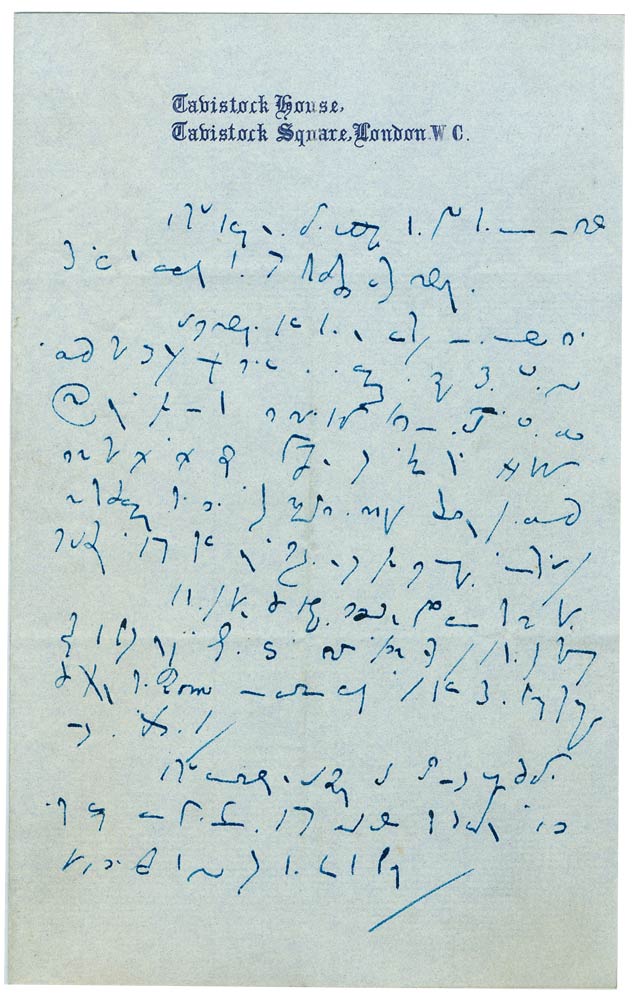Can you help decipher a page of Dickens’s shorthand?
 In my previous post I focused on a letter in which Dickens recalled how, at the age of fifteen, he had applied himself “with a celestial or diabolical energy to the study of such things as would qualify me to be a first-rate Parliamentary Reporter.” In that letter Dickens referred to his mastery of Gurney’s system of shorthand, which he learned under the tutelage of J. H. Barrow, his maternal uncle. In the same letter he proclaimed himself to be “the best Short Hand Writer in the World.” The Morgan’s undated shorthand draft was acquired by Pierpont Morgan some time before 1913, but it seems to have been overlooked by the editors of the Pilgrim Edition. In David Copperfield, Dickens described the system of shorthand created by Thomas Gurney as “that savage stenographic mystery.”
In my previous post I focused on a letter in which Dickens recalled how, at the age of fifteen, he had applied himself “with a celestial or diabolical energy to the study of such things as would qualify me to be a first-rate Parliamentary Reporter.” In that letter Dickens referred to his mastery of Gurney’s system of shorthand, which he learned under the tutelage of J. H. Barrow, his maternal uncle. In the same letter he proclaimed himself to be “the best Short Hand Writer in the World.” The Morgan’s undated shorthand draft was acquired by Pierpont Morgan some time before 1913, but it seems to have been overlooked by the editors of the Pilgrim Edition. In David Copperfield, Dickens described the system of shorthand created by Thomas Gurney as “that savage stenographic mystery.”
I thought that it would be interesting to show a sample of Dickens’s shorthand. This is a single-page shorthand draft. Given that it is written on a sheet bearing the letterhead “Tavistock House,” where Dickens lived from 1851 until 1860, we can assume that it was written sometime during that decade, and that it is possibly the draft of a letter. We know that Dickens used shorthand for drafting letters throughout his life. Such shorthand drafts are extremely rare, probably because the draft was discarded or destroyed once Dickens had copied it out in long hand and put the letter in the mail. The Morgan has only one example of a shorthand draft in Dickens’s hand, and according to the Pilgrim Edition, there are only two other shorthand drafts extant, one at the Charles Dickens Museum in London, and another at the Free Library of Philadelphia.
Can you help solve the stenographic mystery of this manuscript by transcribing Dickens’s shorthand draft? We are eager to know if this shorthand text is a letter, and to whom it is addressed, and exactly when it was written. My working hypothesis is that this text may have been an exercise written for Arthur Stone, the son of Dickens’s friend and illustrator Frank Stone. In 1859, after Frank Stone’s death, Dickens became a second father to Stone’s sons, Arthur and Marcus, and helped them to advance their respective careers. In 1859-1860 he taught Arthur Stone the Gurney system of shorthand and, in 1864, commissioned his brother Marcus to illustrate Our Mutual Friend. The Benoliel Collection, at the Free Library of Philadelphia, has five shorthand notebooks Dickens used to teach Arthur Stone, with extensive notes in Dickens’s hand, and with his corrections of Stone’s shorthand.
Please let me know if you are able to decipher the Morgan’s shorthand draft, it would be a service to scholarship, and would assist us in improving our catalog records.
